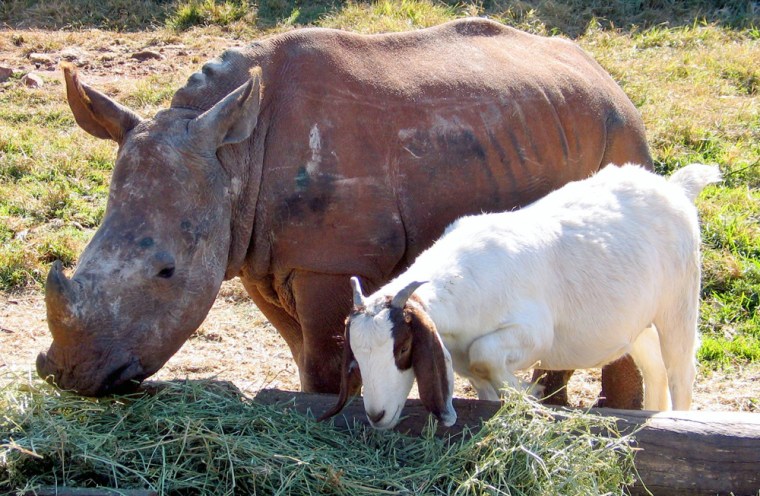A pair of orphans have formed an unlikely bond on a South African game park although horns and a love for horse pellets are about the only things they have in common.
Clover is an 11-month old female rhino calf who was orphaned in the wild when her mother was slain by poachers.
Her constant companion these days is Bok-Bok, a young goat who was also lonely and abandoned.
Improbably, the two made a perfect match and have become inseparable companions at the Rhino and Lion Nature Reserve about 18 miles northwest of Johannesburg.
“One would never have thought that a rhino and a goat would get on very well. We were all shocked,” said Fran Berkowitz, one of their handlers, as side-by-side the pair tucked into a meal of lucerne, a kind of hay used to feed wild game.
“It’s amazing that two different species can get on so well,” she said.
Butting heads
The two sometimes playfully butt heads and spend most waking moments close together.
Clover of course is quickly dwarfing Bok-Bok, whose name is Afrikaans for “goat-goat.”
A white or square-lipped rhino — the second largest land mammal on Earth after the African and Asian elephants — she may eventually reach around 4,000 pounds.
At close to 440 pounds, Clover is already becoming a handful — as evidenced when she briefly charged a startled Reuters cameraman, ramming her stub of a horn into his tripod.
When visitors are in Clover’s pen, lucerne, horse pellets or milk — which she sucks from an oversized baby bottle — are about the only things that keep her from roughing them up.
Wildlife war survivor
Clover’s childhood may be strange, but she is a lucky survivor of Africa’s wildlife wars.
She was orphaned at the age of three months at a reserve in South Africa’s KwaZulu-Natal province when her mother was poached.
Rhinos are targeted in Africa and Asia for their horns, which fetch high prices in Yemen where they are prized for dagger handles and in East Asia where they are used in traditional medicines.
The poaching of the thick-skinned titans is relatively rare in South Africa but a disturbing recent incident has raised alarm bells in the conservation community.
In early May five white rhinos and several other animals were fatally poisoned in a South African nature reserve — a sinister and indiscriminate new tactic.
White rhinos are the most numerous member of the rhino clan but are still endangered. Like their rarer and smaller counterpart the black rhino, the only other African rhino, they are, confusingly, gray in color.
White rhinos were pushed to the brink of extinction a century ago but conservation efforts saved them and they now number several thousand.
Goat may get another orphan
Clover is now in good hands — if unusual company.
“They rely so much on each other, especially the goat. If we let them out for a walk and the rhino goes walking on its own the goat goes absolutely mad,” Berkowitz said.
Still, the time will come when they have to part. In a few months Clover will be released into the 3,460-acre reserve to roam with 10 other rhinos.
But Bok-Bok, who has already proven herself as a “surrogate rhino,” may have another orphan to look after by then.
Bizarre interspecies partnerships are rare but not unprecedented.
In perhaps the most unusual case ever recorded a Kenyan lioness in the wild “adopted” baby antelopes on at least five occasions rather than make meals of them.
Bok-Bok and Clover are at least both horned herbivores.
In 1998, an elephant that was abandoned by its mother became best of mates with a sheep at a South African research center.
That friendship ended tragically when the elephant accidentally crushed the sheep to death, probably when it rolled while sleeping.
